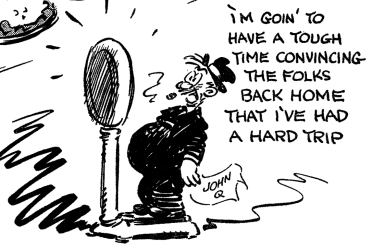
We all know who John Q. Public is. He's the everyman, the man on the street, the guy the representatives in the government represent. He's who they want votes from. What he thinks is what politicians are supposed to listen to and build their platforms on. He's all of us. That said, he isn't just a turn of phrase, but was an actual newspaper comic strip character.
But who was his father?
The idea of a character representing the common man is traced by some back to Frederick Opper's character "Mr. Common People," a small, perpetually nervous looking man in a top hat, who appeared in many Opper political cartoons beginning in 1902. Mr. Common People is most often shown being taken advantage of by people who are far larger than he is. He is also easily identified by the large tag which always hangs off of his coat and reads "The Common People."
John Q. Public himself was created by by Vaughn Shoemaker and first appeared in an editorial cartoon in the Chicago Daily News in 1922. He appeared as a short, balding, messy-haired gentleman and, much like Mr. Common People, was often taken advantage of by larger people around him. An interesting series of cartoons also inserted John Q. Public into photographs depicting various societal problems. The captions mention his concern at what's going on and his confusion at why nothing is being done about it. The cartoons proved popular, and the phrase "John Q. Public" to refer to ordinary citizens lived on far longer than the character did. Many other similar characters cropped up over the years as well. The most notable of these was "Mr. Voter", created by Jim Lange for the The Oklahoman. That character proved so popular, in fact that in 2006 the Oklahoma State legislature adopted him as the state's official editorial cartoon.
Shoemaker had a very successful career even without John Q. Public, and went on to win two Pullitzer prizes for his work. His World War II cartoons were even criticized by Herman Goering himself as "horrible examples of anti-Nazi propaganda," which is high praise in my book. Most of all, he was able to create powerful symbols that stuck in people's minds, as evidenced by the enduring popularity of John Q. Public.
Additional Info:
John Q. Public photo collages at Art Institute Chicago
More of Vaughn Shoemaker's Work at "Comics Should Be Good" blog
Vaughn Shoemaker biography at Wheaton College Archives and Special Collections, and their write-up on John Q. Public
Article on everyman characters at Slate